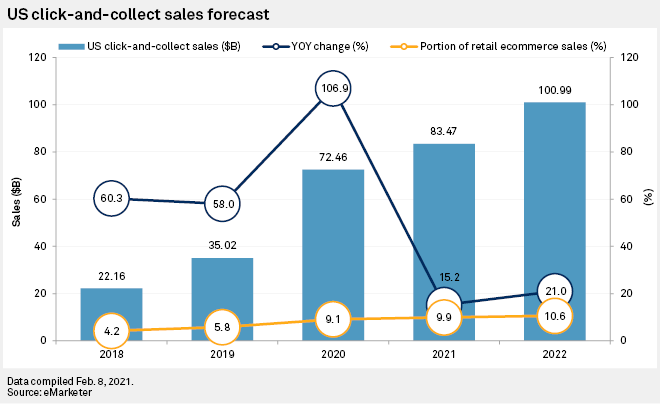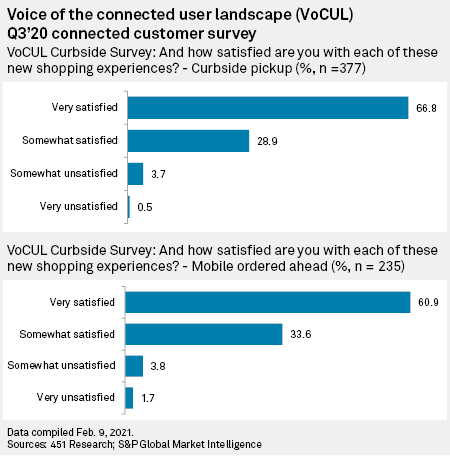S&P Global Offerings
Featured Topics
Featured Products
Events
S&P Global Offerings
Featured Topics
Featured Products
Events
S&P Global Offerings
Featured Topics
Featured Products
Events
Banking & Capital Markets
Economy & Finance
Energy Transition & Sustainability
Technology & Innovation
Podcasts & Newsletters
Banking & Capital Markets
Economy & Finance
Energy Transition & Sustainability
Technology & Innovation
Podcasts & Newsletters
S&P Global Offerings
Featured Topics
Featured Products
Events
16 Feb, 2021
Major brick-and-mortar retailers could fend off competition from online retailer Amazon.com Inc. by continuing to offer curbside pickup and other contactless delivery services that are poised to grow in the coming years, industry experts say.
U.S. sales for "click-and-collect" services are forecast to reach more than $100 billion in 2022, up from $83.47 billion in 2021 and $72.46 billion in 2020, according to the latest data from eMarketer.
Click-and-collect services allow consumers to purchase products online and pick up the items in the store or at a designated area such as a locker, kiosk or parking lot. Demand for these services has grown significantly during the pandemic as they allow U.S. consumers to purchase goods while minimizing physical contact.

Retailers that offer those services, such as Walmart Inc., Target Corp., Home Depot Inc. and Best Buy Co. Inc., have a significant competitive advantage over Amazon thanks to their large store footprints, said Andrew Lipsman, principal analyst at eMarketer.
"These four companies, in particular, I think are very well-positioned for what is likely to be one of the key behaviors that carries forward from the pandemic," Lipsman said.
Amazon does own more than 500 Whole Foods Market Inc. locations and is ramping up a new grocery store concept, but it will take years for Amazon to build out the sort of store footprint that could compete in the click-and-collect arena with retail leaders, Lipsman said.
Buy online pickup order services are nothing new. Some brick-and-mortar retailers began offering the service about a decade ago in part to better compete with Amazon.
But retailers accelerated those services in response to the pandemic as shelter-in-place orders rolled out across the country. Best Buy pivoted to a contactless, curbside-only model in the first quarter and saw a surge in demand in categories including computing, gaming and small appliances. Home Depot expanded its free curbside pickup order service to most stores as an extension of its buy online/pick up in-store option, while Walmart expanded its capacity for pickup and delivery services. Target's order pickup service grew more than 50% in the third quarter while the company's Drive Up service grew more than 500%.
Consumers may eventually trickle back into stores for their entire shopping trip as COVID-19 vaccinations roll out, but the contactless options have become a convenient alternative for in-store shopping, especially in areas such as grocery and home improvement, said Dave Gill, vice president of insights and analytics at Rakuten Intelligence.
Consumers now know they can count on pickup delivery methods as retailers have continued to improve fulfillment and offer substitutions for goods that are out of stock, he said.
"Consumers aren't going to go back," Gill said. "If the experience gets better and I'm not getting the wrong brand or the wrong size, then it's just going to get more entrenched."
The majority of consumers appear to be pleased with curbside pickup. According to 451 Research's latest "Voice of the Connected User Landscape" survey, nearly 67% of respondents who tried curbside pickup services for the first time said they were very satisfied with the experience. Nearly 29% said they were somewhat satisfied, while 3.7% were somewhat unsatisfied. Meanwhile, more than 60% of survey respondents who tried a mobile order-ahead service for the first time reported being very satisfied. That service would include ordering Starbucks coffee online and then picking it up at the store, for example.

Still, curbside pickup is not necessarily a slam dunk for retailers, said Sheryl Kingstone, head of 451's Customer Experience and Commerce research. She noted that there is still a big chunk of consumers who are ambivalent about such services.
Specific use cases for curbside pickup may become more apparent over time, said Jordan McKee, research director at 451. Consumers may take advantage of the service for other reasons besides minimizing contact during the pandemic, including avoiding long lines during the holidays or poor weather, he said.
"You'll start to see some of those specific use cases for curbside stick with consumers that might have tried it for the first time out of necessity longer term as the virus retracts," he said.
451 Research is part of S&P Global Market Intelligence.

